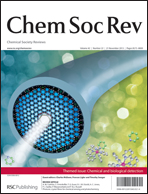Array sensing using optical methods for detection of chemical and biological hazards
Abstract
By mimicking the mammalian senses of taste and smell, artificial arrays of cross-reactive receptors have found use in a variety of sensing applications. Pattern recognition algorithms allow these arrays to be used for discriminating analytes and even for predicting the identity of unknown analytes. Furthermore, in selecting a signaling method for these assays, the choice of optical detection is particularly desirable due to its high sensitivity and the associated convenient instrumentation. This tutorial review provides a brief introduction to array sensing using optical detection and chemometrics. While differential sensing approaches have been used for a number of applications, this review focuses on progress towards the detection of chemical and biological hazards.

- This article is part of the themed collection: Chemical and biological detection

 Please wait while we load your content...
Please wait while we load your content...